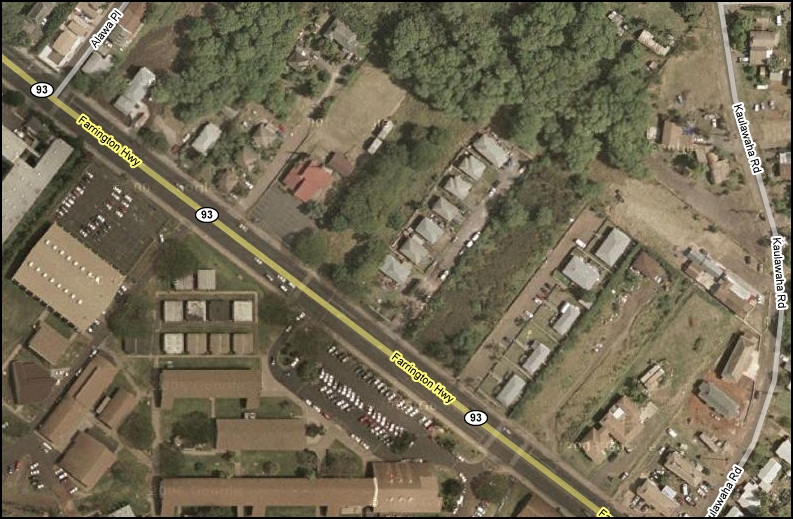Wednesday, February 28, 2007
Makaha death underlines failure of police, Dept. of Transportation, to protect citizens

Both the Advertiser and the Star-Bulletin covered the latest crosswalk death that occurred on Monday in Makaha. Of the two stories, reporter Gene Park's story in the S-B revealed the greater tragedy: the struggle of residents to get the state DOT to take necessary measures to ensure their safety. Corky weighed in with this cartoon.
Neither story mentioned that the DOT knew of the dangers of this crosswalk but has failed to take measures to protect pedestrians. In August 2001 a flashing crosswalk system was installed at that intersection according to this article, but the system was later removed. The installation was described in a DOT press release.
The AARP survey conducted in May 2006 and released in August included monitoring of an intersection near Waianae High School (pictured above), which is one or two away from the Alawa Place scene of the fatal accident. AARP found (at the crosswalk they monitored, which was controlled by traffic signals) that "drivers do not obey traffic signals," that drivers "seem to be speeding," that "car speeds are too fast." The monitors observed "unsafe driver behavior." The monitors also found problems with crossing lights that were too short for people of normal physical ability and other major problems at the nearby intersection they monitored.
The same drivers who speed through the nearby monitored intersection zoom through the Alawa Place intersection, it seems.
Since the publication of the study it appears that the DOT has done nothing to improve the unsafe conditions identified by the AARP. At testimony at the State Capitol, the best DOT could do was to ask for $1 million dollars to hire a consultant for a study that would delay action until 2010.
It's time that we heard from the City about when police will start to enforce the speeding laws already on the books. The blood of these pedestrians is on the City's hands because of their continued inaction. Drivers would pay attention at crosswalks if they expected they would be ticketed. They'd slow down, too, and obey traffic signals.
The state DOT is not much better. Instead of explaining what they will do when questioned by legislators, they consistently explained what they can't (or won't) do. They, too, have blood on their hands.
A clear message is being sent to drivers: no one is watching you, do what you want. The risk that you'll be caught if you violate speed or other traffic laws day after day, all year long, is so low that it's ok if you do it.
 Even if a pedestrian is killed or injured, the focus of news stories is on the pedestrian rather than the driver. Where are the followup stories with photos of drivers facing a judge?
Even if a pedestrian is killed or injured, the focus of news stories is on the pedestrian rather than the driver. Where are the followup stories with photos of drivers facing a judge?Hawaii will likely appear in the record books again if pedestrian fatalities continue at the current pace.
We should not tolerate this. The loss of life in crosswalks and on our streets is mostly avoidable. That we do nothing is inexcusable. That neighbors even have to talk about how many deaths it takes before DOT will install a traffic signal and yet that's the only way to get our government's attention is criminal.
This little blog calls on the Mayor and the Governor to devise and announce plans to turn this around. There is no budget surplus, dear Governor, if your DOT is paralyzed and unable to do anything unless it gets $1 million from the legislature. Your surplus is a profit earned by neglecting public safety--on the streets, near the dams, and no doubt elsewhere.
How many deaths and injuries will it take to get your attention?


Post a Comment
Requiring those Captcha codes at least temporarily, in the hopes that it quells the flood of comment spam I've been receiving.